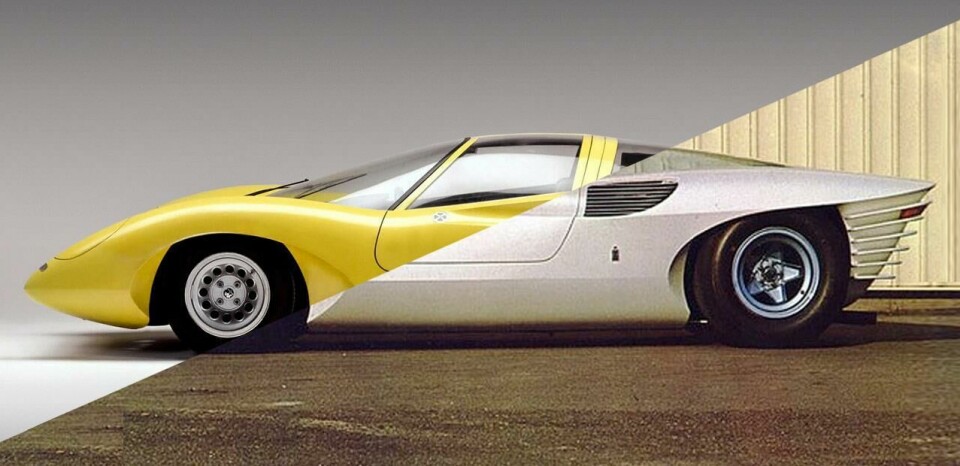
Concept Car(s) of the Week: Ferrari 250 P5 (1968) & Alfa Romeo Tipo 33/2 Coupe Speciale (1969)
Car Design News revisits the Ferrari and Alfa Romeo showcars that shared far more than Italian heritage
In the 1960s Ferrari’s Prototipo ‘P series’ sports car racers proved highly successful in terms of races won and imaginations captured. Of course speed rather than beauty was the goal of these cars, yet the two were seemingly inexorable at a time when intuition was a guiding principle. The P4, designed by Mauro Forghieri and William Casoli was both a zenith and nadir of the genre – perhaps the most beautiful, yet also increasingly outdated at a time when aerodynamics were coming to the fore.

And so Ferrari commissioned Pininfarina to explore advanced aerodynamics for the 250 P5. Young recruit Leonardo Fioravanti was chosen to design the car because of his mechanical engineering education at the Politecnico di Milano where his studies focused on aerodynamics and car body design.

Revealed at the 1968 Geneva motor show, the P5 won immediate acclaim for its futuristic design, even if some Ferrari purists grumbled at its perceived departure from Ferrari design orthodoxy. Built on P4 chassis number 0862, the two-seat coupe featured a three-litre V12 engine mounted in its tail. A walk around the brilliant white car (later repainted red) revealed a design composed of intersecting convex and concave volumes, its ovoid masses contrasting with deeply scalloped recesses for vents and wheel wells.

The design featured a low, concave front fascia with a narrow slot for ventilation for the radiator. Just above this, integrated into the hood, was a bank of headlamps. Flanking this front assembly were pontoon-like fairings for the front wheels. It seems Enzo Ferrari was not overly impressed with this, referring to it as the “suppository”.

More successful were the Dino-like ventilation scoops with flow vanes integrated into the openings while at the rear a strong character line outlines the top of the wheel opening and then ascends and curves across the deck lid. Underneath this somewhat duck-tailed assembly, a strong composition of horizontal vanes covers the tail-lights and engine ventilation openings. It’s clearly a theme Fioravanti was proud of as it was to reappear on his later Testarossa.

The upper body was almost entirely formed of a transparent teardrop canopy, its gullwing doors revealing a spartan composition of two seats, driving controls and little else. Seats were minimally ergonomic and the headrests are built into the firewall that separates the cabin from the engine compartment.

A Gentlemen’s Agreement
As popular as the P5 was on the car show circuit, changing racing rules and the complex and ever-developing programmes at Ferrari soon meant the P5 would not be developed further. Indeed, Fioravanti and his team were already working on a successor, the P6.

As it slowly became public knowledge that P5 was not to be a part of Modena’s future, an unusual request came to Enzo Ferrari from his longtime friend and associate, Dr. Giuseppe Luraghi, Chairman of Alfa Romeo. If Ferrari was not to continue the development of the P5, would he cede the project to his company to develop further? In a move that would be unheard of today, Il Commendatore granted the request.
Over to Alfa Romeo

And so Fioravanti began working anew on the design, adapting it to an Alfa Romeo Chassis, in this case the Tipo 33. Similar in dimensions to the Ferrari, chassis 750.33.115 allowed for a quick adaptation of the P5 design to fit the Alfa Romeo underpinnings, with very minimal changes in proportion or configuration.

Principal changes include the elimination of the headlamp bank in favour of pop-ups located in the front wheel fairings. Along the sides of the car, the airflow vanes in the air scoops were eliminated, as were the strong horizontal vanes along the rear of the car. In their place was a fairly conventional tail-light array, rear fascia, and engine cooling opening.

The concave surfacing along the front fascia was retained however, as was the glasshouse and much of its interior, which had modestly different seats and trim. The colourway was changed, moving away from Pininfarina white and Ferrari red of the original P5 to a brilliant yellow.

The car, now called the Alfa Romeo Tipo 33/2 Coupe Speciale, was revealed at the 1969 Paris motor show. It received an enthusiastic welcome, but there was no disguising its Ferrari origins. Instead of being the first of a new generation of Alfa concept cars, the T33/2 seemed to punctuate the end of an era.

Ironically, it was probably Alfa Romeo itself that sealed the fate of the T33/2, with a concept car from the previous year’s auto show circuit. The radical Marcello Gandini-designed Carabo, with its extreme wedge shape, would be the form giver for the next generation of Italian supercars.
Looking back from more than a generation later, one can’t help but be drawn in by the design of both cars which differ only in their details. Ferrari enthusiasts will naturally be drawn to the familiar details of the P5, while others might enjoy the simpler, slightly purer sculptural form of the T33/2. Both cars speak of an exciting, classic era in Italian design and the rapidly evolving motor sports that drove both design and performance.



